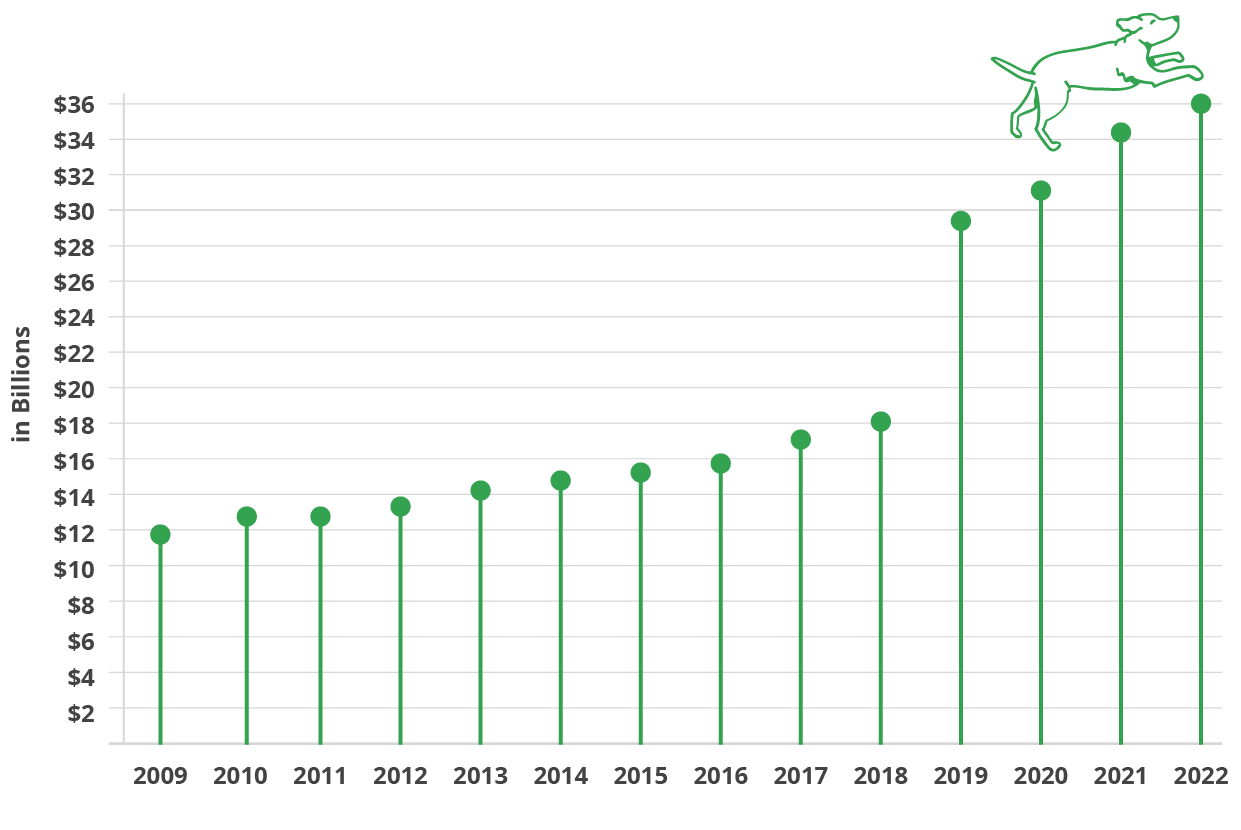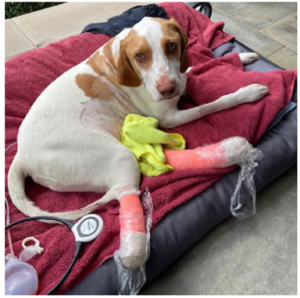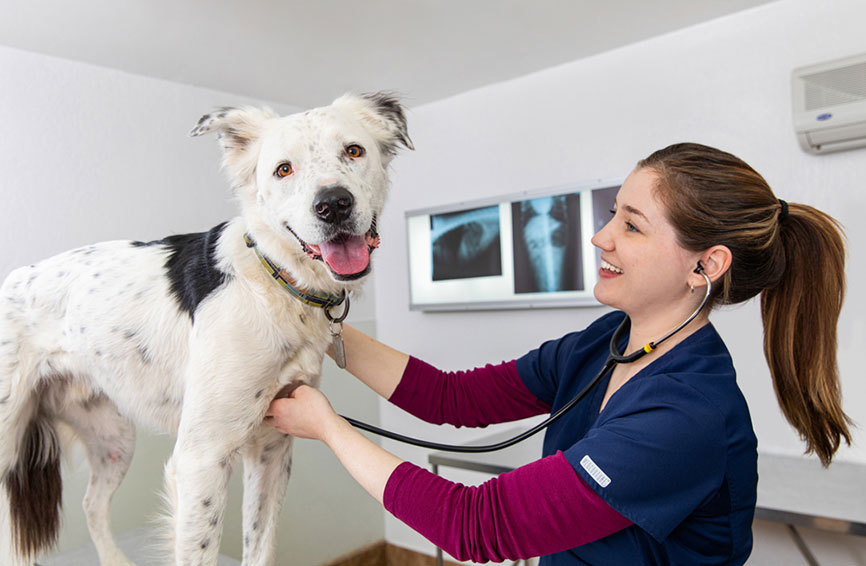Medically reviewed by Dr. Zac Pilossoph, DVM
Updated on May 4, 2023
Introduction
Anyone with a pet knows that vet bills can get expensive quickly and that the costs seem to go up every year. Healthy Paws Pet Insurance has found the reasons for costly pet health care vary from advances in medical treatments to pets living longer to your willingness to spend money and give your pets the treatment they need, just like any other family member. It’s not just medical care we are spending money on. The American Pet Products Association (APPA) estimates pet parents spent $137 billion in overall pet care in 2022.
Healthy Paws pet parents spent more than $442 million on accident or illness veterinary care, and made more than a million claims, based on Healthy Paws closed claims data from Jan. 1 – Dec. 31, 2022. According to the APPA, U.S. pet parents spent nearly 5 percent more on vet care in 2022 than the previous year. Those unexpected visits to veterinary emergency rooms can really hit people in the pocketbook when an emergency vet visit can range anywhere from $200 to $5,000. Thirty-two percent of Americans don’t have even $400 in emergency funds.
This is where pet insurance can help. Pet insurance can allow you to go into vet visits with confidence, knowing that you can do what is best for your pet and you have insurance to help you. The Healthy Paws plan insures new accidents and illnesses, including specialty and emergency care. With no caps on claims payouts and extensive coverage, pet parents can seek the care their pet needs with insurance helping protect against potentially high costs. For this annual report, we dove into Healthy Paws’ claims records to find out what the most common pet health conditions were and how much treatment costs so that pet parents would be aware when adopting a dog or cat.

The cost of veterinary care is increasing
- As medical care is constantly progressing, so is veterinary care
- Procedures once only found in human medicine are now available for dogs and cats:
- Knee replacements
- Advanced allergy testing
- Cancer surgeries
- Bone marrow transplants
- Chiropractic care
- Technological innovations are increasing our pets’ quality of life
- This comes with a corresponding price tag at the vet
Top 10 conditions in dogs*
1. Skin conditions
Average cost estimate: **: $200-$2,500
30.6 % of top ten claims for dogs
Like people, dogs can suffer from various skin conditions, depending on environmental circumstances and genetics. Vets regularly see allergic skin disease, bacterial and fungal infections, insect bites, hot spots, rashes, mange, and more.
Symptoms may include:
- Scratching, itchy behavior including licking
- Dry, flaky skin or dandruff
- Cuts, wounds, abscesses, and sores
- Over-grooming
- Dull or dry coat as well as patchy spots, hair loss
- Folliculitis, acne, and bumps
- Redness
Common treatments/diagnostics the Healthy Paws plan insures for skin issues include:
- Diagnostic tools:
- Hair and skin cultures
- Impression smears
- Punch biopsies
- Allergy testing
- Parasitic treatments (fleas, mites, ringworm, parasites)
- Medicated shampoos and creams
- Antifungal treatments (yeast infection)
- Allergy shots
- Skin cancer treatment including surgery

Merlin, a mini-Aussie, came down with a rare autoimmune disease that affected his skin and required several surgeries to repair. Happily, he made a full recovery, and his pet parents were reimbursed $40,085.
2. Gastritis – stomach issues
Average cost estimate: $1,600-$5,000
17.4% of top ten claims for dogs
Gastrointestinal (stomach) issues can be caused by an extensive list of primary conditions, including gut inflammation, ingesting an indigestible or toxic substance, parasites, infections, some types of cancer, and other serious illnesses. Keep an eye on what your dog eats; life-threatening emergencies happen when dogs ingest bones, toys, and certain human foods that are toxic to dogs.
Symptoms may include:
- Vomiting
- Diarrhea
- Anorexia (not eating or drinking)
- Excessive drooling
- Foaming at the mouth
- Lethargy
- Yelping when touched
Common treatments/diagnostics the Healthy Paws plan insures for stomach issues include:
- Diagnostic tools:
- Lab tests
- X-rays
- Ultrasounds
- Endoscopy
- Antibiotics
- Probiotics
- Parasitic treatments
- Abdominal surgery
Ziggy the Bernedoodle has a habit of eating things she shouldn’t such as socks. This resulted in two surgeries and numerous complications. Fortunately, she sailed through and is doing great.
3. Ear infections (otitis external)
Average cost estimate: $850
10.2% of top ten claims for dogs
Outer ear infections can be painful and annoying, but if they persist to the middle or inner ear, they can lead to neurological damage and deafness. Recurrent bacterial or fungal ear infections often have an underlying cause, such as allergies or abnormal ear anatomy, or ear canal tumors.
Symptoms may include:
- Head shaking or a head tilt
- Scratching at the ear
- Odor in the ear
- Redness or scabbing inside the ear
- Ear is hot to the touch
- Ear is painful/sensitive
- Excess wax, buildup, or crusting in the ear
Common treatments/diagnostics the Healthy Paws plan insures for ear infections include:
- Diagnostics tools:
- Ear culture and sensitivity test
- CT scans
- Advanced orthoscopy
- Ear cleaning to flush out debris
- Antibiotics
- Anti-inflammatories
- Antifungal treatments
- Pain medication
- Surgery (required for some conditions and end-stage chronic ear inflammation)
4. Eye conditions
Average cost estimate: $1,100
9.4% of top ten claims for dogs
Despite there being numerous causes for eye conditions, many if not most of them will initially look the same from the outside. Common eye conditions include corneal abrasions, ulcers, and infections, glaucoma, cataracts, dry eye and cherry eye. Almost all of these can lead to pain and even vision loss if not addressed. A vet should check out all eye conditions immediately to reduce the chance of long-term damage.
Symptoms may include:
- Blindness
- Redness
- Discharge or watery eyes
- Crustiness
- Squinting
- Pawing at the eye or face
- Dry eye (excessive blinking and eyes or eyelids seem swollen)
- Decreased appetite due to eye and facial pain
Common treatments/diagnostics the Healthy Paws plan insures for eye conditions include:
- Diagnostic tools:
- Schirmer tear test
- Intraocular pressure test
- Fluorescein stain
- Ophthalmoscopy (evaluation of the inner eye)
- Antibiotics and eye drops
- Parotid Duct Transposition (PDT) surgery (for dry eye)
- Cherry eye surgery
- Cataract and other eye surgeries
- Drops and surgery for glaucoma
- Enucleation (eye removal)

Cleo, a Bichon Frise, had a retina tear in one of her eyes, threatening her eyesight. She got the surgery she needed and her pet parents can see the light in her eyes again. They were reimbursed $8,408.
5. Cruciate ligament injury (CCL)
Average cost estimate (for surgery): $2,000-$5,000
5.9% of top ten claims for dogs
A Cranial Cruciate Ligament (CCL) rupture for a dog (similar to an ACL rupture in people) is an injury to an important ligament in the knee joint that often requires surgery to repair. Genetics plays a role in the development of CCL ruptures.
Symptoms may include:
- Sudden pain
- Limping
- Sometimes punctuated with a yelp or whimper
- Swelling
- Stiffness
- Abnormal sitting positions
- Difficulty getting up
- Decreased activity levels
- Change in behavior (ex: not jumping in the car anymore)
Common treatments the Healthy Paws plan insures for CCL injuries include:
- Diagnostic tools:
- Lab tests
- X-rays
- CT scans
- Surgery:
- TWO (Tibial Wedge Osteotomy)
- Extracapsular Repair Surgery (the joint is tightened)
- Tibial Tuberosity Advancement (stabilizes the joint, less invasive than the procedure below)
- TPLO (Tibial Plateau Leveling Osteotomy)
- Recovery options include laser therapy, hydrotherapy, massage, and acupuncture.

Izy, a five-year-old English cream golden retriever, suddenly started to limp during a play date. She had torn her cranial cruciate ligaments (similar to an ACL tear in humans) in both legs.
She had tibial plateau leveling osteotomy (TPLO) surgery on both legs – five months apart. After a few months, she was back to going on walks and is nearly back to normal. Her pet parent was reimbursed $6,700.
6. Growths and tumors
Average cost estimate: $300-$1,600
5.7% of top ten claims for dogs
This can be any abnormal lump, bump, or mass on your dog’s skin or elsewhere in their body. It could be an infection, cyst or benign tumor, or in the worst case, malignant cancer that requires removal and other treatment.
Symptoms may include:
- Any protrusion, lump, bump, or foreign growth qualifies
- Swelling
- Sores that won’t heal
- Strange odors
Common treatments/diagnostics the Healthy Paws plan insures for growths and tumors include:
- Diagnostic tools:
- Fine needle aspirates
- Biopsy
- Cyst drainage
- Traditional or laser surgery
- Chemotherapy and radiation (when cancerous)

Juniper, a mixed breed rescue, developed a growth that was found to be cancerous. It was surgically removed, and she remains cancer-free. Juniper’s pet parents were reimbursed $3,038.
7. Heart conditions
Average cost estimate: $1,500-$2,500
5.5% of top ten claims for dogs
Heart disease in dogs is almost as common as in humans. In fact, approximately 10 percent of all dogs in the U.S. have heart disease. Heart issues in dogs can include heartworm disease, dilation of the heart, a thickening of the heart muscle, valve disease, and congestive heart failure (CHF), which is end-stage heart disease. The most common form of heart disease is chronic degenerative valvular disease, which makes up 75% of heart disease in dogs, and primarily affects small breed dogs over the age of five, according to VCA Hospitals.
Symptoms may include:
- Fatigue
- Reduced interest in exercise or exercise intolerance
- Difficulty breathing
- Loss of appetite
- Weight loss
- Distended abdomen
- Trouble sleeping
- Coughing
- Fainting or passing out
Common treatments/diagnostics the Healthy Paws plan insures for heart conditions include:
- Diagnostic tools:
- Blood pressure monitoring
- Echocardiogram
- Blood test
- Electrocardiograph (ECG)
- X-rays
- Heartworm test
- Heartworm treatment (if positive)
- Prescriptions: Diuretics, drugs to relax blood vessels, drugs to help the heart muscle function more effectively.
8. Seizures
Average cost estimate: $200-$500
5.3% of top ten claims for dogs
Seizures are caused by an abnormally excessive amount of electrical activity in the front part of the brain. Seizure activity can present in various ways, from facial twitching to uncontrollable full-body convulsions, and can last from several seconds to minutes. Causes for seizures can include conditions inside the brain (idiopathic epilepsy, stroke, infection, inflammation, brain cancer) or outside the brain (liver or kidney disease, low blood sugar levels, or ingesting poison).
Symptoms may include:
- Collapsing or falling to one side
- Uncontrollable convulsions: tonic-clonic contractions and tremors that include both the face and limbs
- Loss of consciousness or vision
- Excessive drooling or “foaming” at the mouth
- Loss of bowels or urine
- Signs of panic, bewilderment, or confusion; dazed or ‘far away’ look
- Teeth chomping; chewing
Common treatments/diagnostics the Healthy Paws plan insures for seizures include:
- Diagnostic tools:
- Bloodwork
- Blood pressure check
- Urine testing
- Thyroid testing
- MRI
- Spinal tap
- Anticonvulsant medication (in the case of epilepsy)
- Antibiotics (for infections)
- Chemotherapy, radiation or surgery (if the cause is cancer)

Guapo, a Biewer terrier, started suffering seizures when he was only two years old. He was diagnosed with epilepsy. While not curable, Guapo’s condition is now under control with a daily dose of anticonvulsants. His pet parent was reimbursed $1,365 and receives monthly reimbursements for the medication.
9. Urinary Tract Infections (UTIs)
Average cost estimate: $450
5.1% of top ten claims for dogs
Urinary tract infections (UTIs) are common in dogs and can develop at any time throughout their lives. UTIs are caused by bacteria that usually enter the urethra and travel up to the urinary bladder, where they multiply and colonize. Common symptoms include frequent urination, straining, discomfort, and discolored urine. They occur less frequently in male dogs due to their longer, narrower urinary tracts.
Symptoms may include:
- Frequent urination
- Blood in urine
- “Dribbling” urine
- Straining to urinate
- Whining or whimpering
- Break in housetraining
- Obsessive licking of the genital area
Common treatments/diagnostics the Healthy Paws plan insures for UTIs include:
- Diagnostic tools:
- Lab tests (Urinalysis)
- X-rays
- Ultrasounds
- Pain medication
- Antibiotics
10. Allergies
Average cost estimate: $600-$1,100
4.8% of top ten claims for dogs
Just like humans, cats and dogs can suffer from a variety of allergies, including environmental/seasonal, food and flea saliva allergies. Once you know what your dog is allergic to, you may be able to avoid it or seek treatment. A hypoallergic or elimination diet may be used to determine food allergies.
Symptoms may include:
- Vomiting
- Diarrhea
- Excessive flatulence
- Straining to urinate
- Skin painful or hot to the touch
- Redness, itching, hives, scales, or sores
- Ear or anal gland irritation
- Sneezing, watery eyes, and general lethargy
Common treatments/diagnostics the Healthy Paws plan insures for allergies include:
- Diagnostic tools:
- Skin or blood allergy testing to determine what the allergy is
- Culture or cytology to determine best type of treatment
- Immunotherapy
- Oral or injectable medications
- Anti-itch topical medications or ointments
- Prescription shampoos
- Prescription foods
- Steroids (short-term)
- Fatty acids

Rue was allergic to every type of tree, grass and pollen, and the constant itching was making her miserable. Rue got the relief she needed with monthly allergy shots and now she can romp outside. Her Healthy Paws plan covered $1,136 of the initial testing and treatment bill of $1,400 and continues to pay 90 percent of her monthly shots three years later.
Top 10 conditions in cats*
1. Gastritis – stomach issues
Average cost estimate: $1,500-$1,800
20.5% of top ten claims for cats
Gastrointestinal (stomach) issues can be caused by a few primary conditions, including gut inflammation, ingesting an inedible object or toxic substance, parasites, infections, some types of cancer, and other serious illnesses. Keep an eye on what your cat eats; life-threatening emergencies happen when cats ingest strings, tape, other linear objects, and several household plants.
Symptoms may include:
- Prolonged vomiting
- Diarrhea
- Anorexia and weight loss
- Abdominal pain
- Bloating
- Constipation
- Dull coat
- Excessive thirst
Common treatments/diagnostics the Healthy Paws plan insures for gastrointestinal issues include:
- Diagnostic tools:
- Lab tests
- FIV and Leukemia testing
- X-rays
- Ultrasound
- Endoscopy
- Antibiotics
- Probiotics
- Parasitic treatments
- Stomach surgery

Blue, a Siberian Forest Cat, is interested in eating all kinds of things. Unfortunately, this resulted in him eating part of a lily, which are poisonous to cats. The vet treated him with IV fluids and medication, and he recovered. His pet parent was reimbursed $2,345.
2. Urinary tract infections (UTIs) or Feline Lower Urinary Tract Disease (FLUTD)
Average cost estimate: $1,050
13% of top ten claims for cats
Cats are more prone than dogs to see the vet for urinary problems, which have similar symptoms like urinating small amounts frequently and having accidents outside the litter box regardless of the underlying cause. FLUTD describes a variety of conditions that affect the bladder and urethra of cats. Infections are more common in much older cats and those with underlying health problems like diabetes, while younger cats often develop an inflammatory condition called idiopathic cystitis or develop urinary bladder stones. The underlying cause is due to multiple factors: bladder and hormone abnormalities, environmental stressors, infections, and urinary stones or sand, which may obstruct the normal flow of urine.
Symptoms may include:
- Painful urination or straining to pee
- Bloody or cloudy urine
- Frequent trips to the litter box or urinating outside the box
- Constant licking of the genital area
- Lethargy
- Vomiting or diarrhea
- Hard or distended abdomen
- Poor appetite
- Low energy
- Decreased social interaction
Common treatments/diagnostics the Healthy Paws plan insures for UTIs and FLUTD include:
- Diagnostic tools:
- Lab tests (urinalysis)
- X-rays (to screen for blockages)
- Ultrasounds
- Urine culture
- Bloodwork
- Antibiotics
- Pain medication
- Laser therapy
- Surgery, including perineal urethrostomy (surgical bypass of the urethra, sometimes performed after chronic urinary blockages
- IV fluid therapy
- A urinary catheter
- Medications for pain and swelling.
- Hospitalization

Checkers the cat was straining to pass urine and his bladder was the size of a lemon. Checkers required emergency surgery to remove a blockage in his urinary tract and fully recovered. His pet parents were reimbursed $1,860.
3. Skin conditions
Average cost estimate: $200-$2,500
12.8% of top ten claims for cats
Cats can be afflicted with a myriad of skin conditions, such as infections, parasites or allergies. The most common symptoms are itchiness, dry or flaky skin, hair loss, and over-grooming. A vet can identify a cause through diagnostic tests and start a treatment plan.
Symptoms may include:
• Scratching, itchy behavior
• Dry, flaky skin or dandruff
• Cuts, wounds, abscesses and sores
• Over-grooming
• Dull or dry coat as well as patchy spots, hair loss
• Folliculitis, acne and bumps
• Redness
Common treatments/diagnostics the Healthy Paws plan insures for skin conditions include:
- Diagnostic tools:
- Hair and skin cultures
- Impression smears
- Punch biopsies
- Allergy testing
- Antibiotics
- Parasitic treatments (fleas, mites, ringworm, parasites)
- Medicated shampoos and creams
- Antifungal treatments (yeast infection)
- Allergy shots
- Skin cancer treatment, including surgery
4. Heart conditions
Average cost estimate: $1,500
9.2% of top ten claims for cats
Heart issues in cats can include hypertrophic cardiomyopathy, complications from blood clots, and heart valve issues. There is no cure for heart disease, but most heart conditions can be managed for a period with medications. It is important to know that early heart disease will not often show outward signs. A veterinarian can often detect heart changes much earlier in the disease process, making it crucial to have your cat evaluated annually.
Symptoms may include:
- Coughing or difficulty breathing
- Rapid breathing
- Weakness
- Lethargy
- Decreased appetite
- Weight loss
- Sudden paralysis of one or more legs (due to blood clots)
- Distended abdomen
- Trouble sleeping
Common treatments/diagnostics the Healthy Paws plan insures for heart conditions include:
- Diagnostic tools:
- Blood test
- Blood pressure monitoring
- Electrocardiogram (EKG)
- Echocardiogram
- X-rays
- Medications: Diuretics, drugs to relax blood vessels, drugs to help the heart muscle function more effectively, and anti-clotting medication.

Hugo the cat was recovering from spinal disc surgery when it was discovered he had congestive heart failure, among several other conditions, all treatable. His pet parents were reimbursed $30,847.
47 percent of people have gone into personal debt paying for vet services, with the average debt being $1,458.†
5. Eye conditions
Average cost estimate: $700-$2,000
8.3% of top ten claims for cats
Eye conditions affecting cats can include conjunctivitis, corneal ulcers and wounds, uveitis, retinal damage, and more. A veterinarian should check out all eye conditions immediately to reduce the chance of long-term damage. Treatment can vary widely depending on the underlying condition, from eye drops to surgery.
Symptoms may include:
- Blindness
- Redness
- Discharge or watery eyes
- Itchiness Symptoms
- Crustiness
- Squinting
- Pawing at the eye or face
- Dry eye sometimes expressed by excessively blinking and swollen eyes (or eyelids)
- Decreased appetite due to eye and facial pain
Common treatments/diagnostics the Healthy Paws plan insures for eye conditions include:
- Diagnostic tools:
- Schirmer tear test
- Intraocular pressure test
- Fluorescein stain
- Advanced ophthalmoscopy
- For eye infection: antibiotic ointment
- Pain-relieving eye drops
- Antiviral medicines (to treat feline herpes)
- Cataract surgery
- Glaucoma drops and surgery
- Enucleation (eye removal)
6. Infections
Average cost estimate: $300-$2,000
7.2% of top ten claims for cats
There are various types of bacterial infections that can affect cats and their major organs. The symptoms of bacterial infections in cats are specific to their location and severity. Infections can also be caused by viruses, fungi, and other microorganisms.
Symptoms may include:
- Fever
- Lethargy
- Poor appetite
- Skin abscesses, lesions or inflammation
- Coughing and runny nose
- Red and runny eyes
- Constant vomiting
- Pain
- Lameness
Common treatments/diagnostics the Healthy Paws plan insures for infections include:
- Diagnostic tools:
- Blood tests (fungal panels, respiratory panels)
- Skin biopsies
- Ultrasound
- Antibiotics
- Topical or pain medication
- Minor surgery to remove infectious liquid or a foreign body
7. Diabetes
Average cost estimate: $1,600
7.2% of top ten claims for cats
Cats commonly develop type II diabetes mellitus. Most diabetic cats are initially overweight, which leads to insulin resistance—a reduced ability of cells in the body to respond to insulin. Insulin resistance results in abnormally high blood sugar levels. Left untreated, diabetes can lead to weight loss, loss of appetite, vomiting, dehydration, coma and even death. Diabetes can be controlled with insulin injections, dietary management, and weight loss. Sometimes, Type II diabetes can be reversed and cats go into remission.
Symptoms may include:
- Excessive thirst and urination
- Vomiting
- Oily, dandruff-laden coat
- Lethargy
Common treatments/diagnostics the Healthy Paws plan insures for diabetes include:
- Diagnostic tools:
- Urine test for glucose or ketones
- Blood test to determine glucose levels
- Ultrasound
- Glucose monitoring
- Daily insulin
8. Kidney disease
Average cost estimate: $1,300
7.1% of top ten claims for cats
Chronic kidney disease is a common ailment in older cats. Acute kidney injury is a severe condition with a relatively sudden onset. Many kidney conditions may be managed with a special diet, medications, and fluid therapy.
Symptoms of a chronic condition may include:
- Increased thirst
- Increased urination
- Weight loss
- Decreased appetite
- Lethargy
- Vomiting
Symptoms of acute failure may include:
- Vomiting
- Bad breath
- Weakness
- Loss of coordination
Common treatments/diagnostics the Healthy Paws plan insures for kidney disease include:
- Diagnostic tools:
- Blood tests
- Urinalysis
- Ultrasound
- Blood pressure testing
- Fluid therapy (IV)
- Medications
- Lithotripsy (ultrasound shock waves to break apart kidney stones or bladder stones)

Fern the cat had a kidney stone blockage that required surgery to remove. She fully recovered and her pet parents were reimbursed $12,846.
9. Cancer
Average cost estimate: $3,000-$5,000
6.4% of top ten claims for cats
Cancer is caused by the rapid division of cells that often form masses or tumors in various parts of the cat. While it mainly occurs in older pets, it can happen at any age. It can be found in almost every part of the body, from the bones to the brain. It can be hard to detect early in cats as they tend to hide signs of discomfort. The earlier the cancer is caught, the better the chances of successful treatment.
Symptoms of cancer may include:
- Lumps or masses
- Lack of appetite or weight loss
- Difficulty urinating or defecating
- Fluid discharge or bad odors
- Limping or lameness
- Sores that do not heal
- Lethargy
Common treatments/diagnostics the Healthy Paws plan insures for cancer include:
- Diagnostic tools:
- Magnetic Resonance Imaging (MRI) scan
- Computed Tomography (CT) scan
- Fine needle aspirate and cytology
- Bloodwork
- X-rays
- Ultrasound
- Cytology and/or biopsy of a mass
- Lymph node FNA cytology
- Radiation
- Chemotherapy
- Surgery

Billie is a nearly 13-year-old cat who has survived several health scares, including cancer. Three years ago, she underwent surgery to remove a tumor in her small intestine followed by six months of monthly chemotherapy treatments. The total vet bills for the cancer were $4,319, with Healthy Paws reimbursing $3,776. Today, Billie is a healthy, happy senior cat.
10. Abdominal conditions (stomach, intestines, liver, spleen, bladder)
Average cost estimate: $1,500
5.3% of top ten claims for cats
Conditions involving the abdomen can include anything related to the internal organs such as the stomach, intestines, kidneys, liver, spleen, or bladder. This can include fatty tissue in organs, inflammation of the intestines (colitis) or stomach, bacteria, digestive problems, liver disease, gastrointestinal obstruction, ulcers, inflammatory bowel disease and more.
Symptoms may include:
- Vomiting
- Diarrhea
- Loss of appetite
- Weight gain or loss
- Constipation or difficulty passing urine or feces
- Lethargy
- Pain
- Bloody stool
Common treatments/diagnostics the Healthy Paws plan insures for abdominal issues include:
- Diagnostic tools:
- Urinalysis
- X-rays
- Bloodwork
- Biopsy
- Ultrasound
- Surgery
- Antibiotics
- Medication: Pain, gastro protectants, anti-diarrheal, etc.
- IV fluids

Jinx the cat was gaining a lot of weight over a six-month period, was less vocal than usual and had been unable to groom herself. She had a mass of fatty tissue pushing her internal organs to one side of her body, which required surgery to remove. Her pet parent was reimbursed $1,145 of the $1,431 vet bill.
Claims of fame

Scooter, pointer mix
Total claims: $74,100
Healthy Paws reimbursed: $58,897
Coverage: $250 deductible with 80 percent reimbursement level insurance coverage.
Scooter, a 3-year-old rescue dog had a very rough year in 2021. His pet parent accidentally hit him with her car in their driveway in September. The accident caused chest trauma and blood in the chest cavity, serious wounds on his hind legs, a left hind femur fracture, pelvic fractures, torn tendons, a hernia in the diaphragm, and a burst spleen. He was already living with an amputated right foot – a condition that preceded his adoption.
Scooter underwent a total of six surgeries. After the surgeries, Scooter continued recovering with the help of a barometric oxygen chamber and laser treatments. Miraculously, his pet parent reports that six months later, Scooter is back to normal and can run, swim and play as before. She was very relieved to have had pet insurance and was so impressed with the service that she has signed up her new family member – Coco, another pointer mix.
Reimbursement was based on covered treatments using an 80% reimbursement level and a $250 annual deductible.

Nene, Persian cat
Total claims: $30,905
Healthy Paws reimbursed: $27,724
Coverage: $250 deductible with 80 percent reimbursement level insurance coverage.
Nene, a one-year-old Persian cat, was not feeling well in December and her pet parent took her to the vet. She was diagnosed with pyothorax, a condition where inflammatory fluid collects in the space around the lungs. The vet placed a chest tube in her right side to help drain the fluid in the lungs so she could breathe easier. The fluid was found to contain bacteria, so Nene remained hospitalized for 11 days on oxygen, antibiotics, pain medications, anti-nausea medication and appetite stimulants. Some complications required more testing and treatment. Finally, Nene was able to go home with antibiotics and pain medications.
32% of Americans don’t have $400 in savings†
It’s heart-breaking to imagine turning down crucial treatment for your pet due to finances.
Luckily, more people are choosing pet insurance – new enrollments in the U.S. grew nearly 28% from 2020-21.†
How does pet insurance work?
Pet insurance is for those unexpected accidents and illnesses you just can’t plan for — like when the dog eats something he shouldn’t or if the cat is diagnosed with diabetes. It works differently than human healthcare plans as it is reimbursement based, so you don’t have to worry about a provider being “in-network” and can simply use any licensed vet (even emergency and specialty hospitals). With the Healthy Paws plan, you can give your pet the necessary care and may be reimbursed up to 90 percent of your covered vet bills. There are substantial differences between pet insurance policies which can affect coverage and claim reimbursement. The Healthy Paws plan covers new accidents, injuries and illnesses with no caps on claim payouts, and includes breed-specific, congenital, and chronic conditions. Customers benefit from this easy-to-understand policy and our personalized customer support. By getting health coverage for your furry family member, you can be there for them when they need you the most. After all, they’re always there for you.
How to get reimbursed for a covered claim



Key takeaways
We’ve talked to many pet parents, and many say they wished they’d signed up for pet insurance before their pet got sick or injured. They simply didn’t know how expensive vet bills could be and weren’t prepared financially. It’s heart-breaking to imagine turning down crucial treatment for your pet due to financial constraints. Here at Healthy Paws, we strongly believe that pets are family – in fact, we’re not alone! 85% of dog owners and 76 percent of cat owners believe this – and that you try your best to look after your family. Pets bring you joy, love, and good health, and you can return the favor by making pet health care a priority. More people are turning to pet insurance, with the growth rate in U.S. pet insurance enrollments nearly 22 percent from 2021-22. This allows pet parents to say “yes” to important vet care knowing they have insurance that can help them.
† Sources: The American Pet Products Association (APPA), Lending Tree, North American Pet Health Insurance Association. (NAPHIA), the Federal Reserve and Phys.org.
*Based on Healthy Paws Pet Insurance claims data between January 1, 2022 – December 31, 2022
**Estimated costs from CareCredit, myaccessvetcare, Preventive Vet, Daily Paws, Great Pet Care, and Healthy Paws claims data.
Always seek the advice of your veterinarian or other qualified health provider with any questions you may have regarding a medical diagnosis, condition, or treatment options.
For full coverage details and exclusions see a sample policy.
The claim scenarios described here are intended to show the types of situations that may result in claims. These scenarios should not be compared to any other claim. Whether or to what extent a particular loss is covered depends on the facts and circumstances of the loss, the terms and conditions of the policy as issued and applicable law.
Insureds providing testimonials in this report have not received compensation for their statements.
Plan coverage varies based on the age of the pet at enrollment and the deductible and reimbursement levels chosen at enrollment. Exclusions and restrictions apply. All descriptions or highlights of the insurance being provided are for general information purposes only, do not address state-specific notice or other requirements and do not amend, alter or modify the actual terms or conditions of an insurance policy. Please refer to the terms and conditions of the policy, which set forth the scope of insurance being provided and address relevant state requirements.
Insurance offered by Healthy Paws Pet Insurance is provided by ACE American Insurance Company, Westchester Fire Insurance Company, Indemnity Insurance Company of North America, ACE Property and Casualty Insurance Company and Atlantic Employers Insurance Company and one or more of their U.S.-based Chubb underwriting company affiliates. Chubb is the marketing name used to refer to subsidiaries of Chubb Limited providing insurance and related services. For a list of these subsidiaries, please visit our website at www.chubb.com. This communication contains product summaries only. Coverage is subject to the language of the policies as actually issued. Surplus lines insurance sold only through licensed surplus lines producers. Chubb, 202 Hall’s Mill Road, Whitehouse Station, NJ 08889-1600.
Healthy Paws Pet Insurance & Foundation is the brand name for the program operations of Healthy Paws Pet Insurance, LLC. Healthy Paws Pet Insurance, LLC is a licensed producer in all states (TX license # 1636108); operating in California as Healthy Paws Pet Insurance Services, LLC (CA license #0H16053), and in New York as Healthy Paws Pet Insurance Agency, LLC.
© 2023 Healthy Paws Pet Insurance, LLC. All Rights Reserved.


